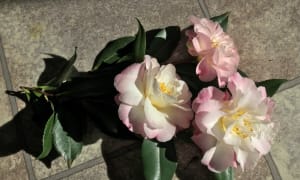
The Murrumbidgee Field Naturalists got to see the fiery red Rankins Springs grevillea on their trip to Pulletop Nature Reserve. Photo: Nella Smith

The Murrumbidgee Field Naturalists got to see the stunning Scarlet Mintbush on their trip to Pulletop Nature Reserve. Photo: Nella Smith
A trip to the Mallee is essential in Spring as it offers so much biodiversity especially this year because we’ve had rain.
The fragile nature of this ecosystem that can be so easily destroyed by wind and water erosion when disturbed, results from the unreliability and distribution of the rainfall in this arid environment.
The remarkable thing is the plants have adapted to a tough environment with hot summers, freezing winters and rainfall no more than 250mm a year.
The multi-stemmed mallee gums have lignotubers which retain some life even when the going is tough.
The wattles have modified leaves that transpire little and the little plants wait for a shower and quickly grow and flower and seed when it comes.
The early settlers found out that when they cleared the trees the soil simply blew away. They may have grown one or two good crops and then drought beat them back and they often walked off their farms.
Fortunately, there are a few parcels of land and road easements that were not cleared and roadside vegetation had to be retained to a width that a cricket pitch is long.
So, we have a few wonderful refuges remaining.
Pulletop Nature Reserve managed by NPWS is one such reserve found north of Griffith.
Local landholders have also retained some parcels of land over three or four generations.
Normally special permission is required to visit NPWS nature reserves unlike National Parks which have visitor facilities. The endangered Malleefowl was found here until about 1960.
Murrumbidgee Field Naturalists were privileged to be invited to visit the reserve recently. We also visited an enclosure on private land.
Two species of grevillea were seen, the fiery red Rankins Springs Grevillea and the creamy coloured Spiny cream Spider Flower.
Three species of pea, Mallee Bush Pea, Broom Bitter Pea and Sandhill Bitter Pea. You can tell they are bitter peas when you bite into them.
There are two special mint bushes specific to good mallee patches: Scarlet Mintbush and a Small Mintbush. To arouse your senses even further there were Scented Mat-rush which you can smell across the landscape. Four or five species of wattle makes it a good patch.
On the ground, particularly in the enclosure was a myriad of small white, yellow and purple daisies.
A smattering of the Mallee Blue-flower, the yellow of Goodenias and Hibbertias gave the ground some cover. Spinifex occurs in this landscape and although we find it prickly the small mammals and reptiles that live there love it for food and shelter.
The toughness of the environment makes it diverse but fragile. We all enjoyed our visit to these special woodlands.






